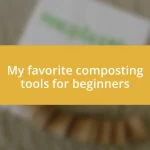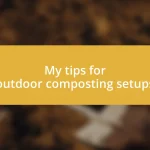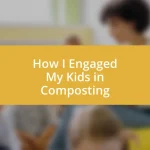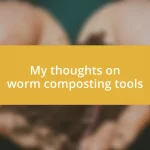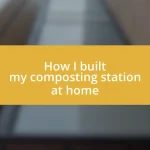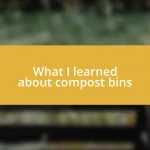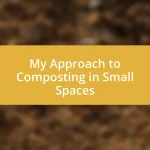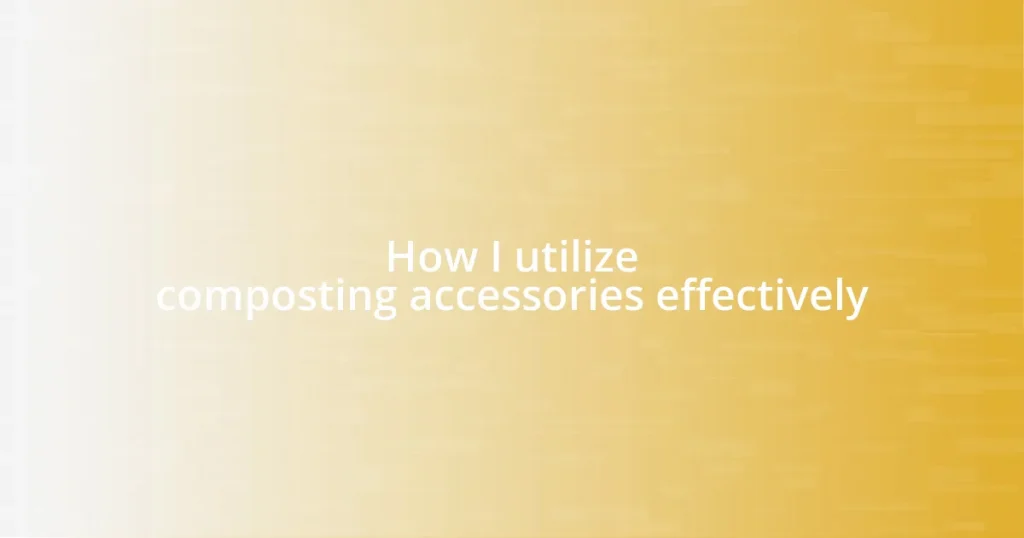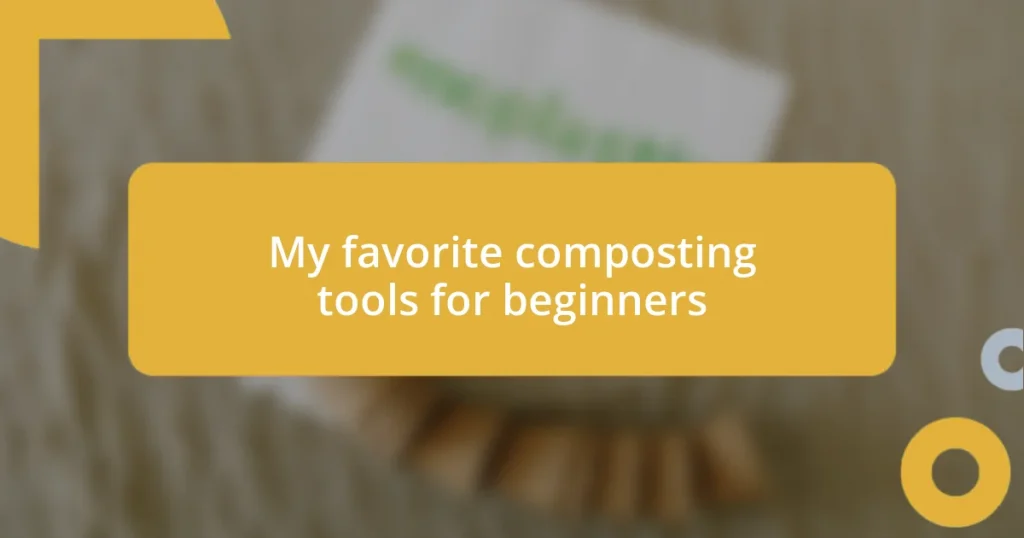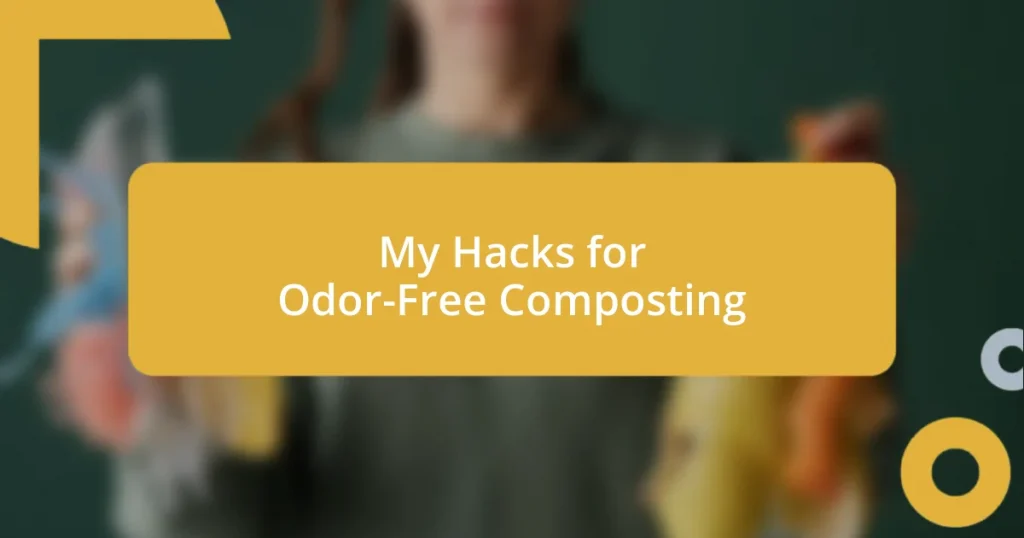Key takeaways:
- Composting transforms organic waste into nutrient-rich soil through a balance of carbon-rich “browns” and nitrogen-rich “greens,” enhancing soil health and biodiversity.
- Key benefits of compost include improved soil structure, increased water retention, boosted nutrient content, and stimulation of beneficial microbial activity.
- Practices like monitoring temperature, regularly turning the compost, and incorporating various textures can enhance composting efficiency and prevent common issues like odor or pests.

Understanding composting fundamentals
Composting is truly a fascinating process that transforms organic waste into nutrient-rich soil. I remember the first time I started composting in my backyard; seeing kitchen scraps evolve into dark, crumbly goodness felt like magic. Isn’t it amazing how nature has its way of recycling materials that would otherwise end up in the landfill?
At its core, composting involves a balance of carbon-rich “browns” and nitrogen-rich “greens.” When I first learned to layer my compost, I was struck by how simple it is yet how profound the impact is on the resulting soil health. Have you ever wondered how a handful of soil can host billions of microorganisms working tirelessly to break down organic matter? This biodiversity is essential for creating healthy compost and ultimately supports vibrant plant life.
When I finally achieved that perfect compost mix, the feeling of satisfaction was immense. It struck me how composting isn’t just about waste management; it’s a gateway to a deeper connection with nature. When I watch my plants thrive with the very soil I nurtured, it’s a reminder that caring for our environment starts right in our own backyards.

Benefits of compost for soil
One of the most profound benefits of compost for soil is its ability to improve soil structure. After incorporating compost into my garden, I noticed the difference almost immediately. The soil became looser and richer, allowing roots to penetrate more easily and plants to access water and nutrients effectively. The emotional joy of watching my struggling plants bounce back was truly gratifying—I felt like I had given them a new lease on life.
Here are some key benefits of compost for soil health:
- Enhances soil structure and aeration.
- Increases water retention.
- Boosts nutrient content and availability.
- Stimulates beneficial microbial activity.
- Reduces soil erosion by improving stability.
When I started adding compost to my potted plants, the increase in their growth rate was astonishing. I could hardly believe how much more vibrant their leaves became and how resilient they were against pests. That transformation reminded me that composting is not just a chore—it’s a powerful tool for nurturing the earth.

Key ingredients for effective compost
When it comes to creating effective compost, selecting the right ingredients is essential. I’ve found that using a mix of “browns” and “greens” not only enhances the quality of the compost but also speeds up the decomposition process. For me, collecting leaves in the fall and combining them with vegetable scraps throughout the year has been my go-to strategy. There’s something deeply satisfying about knowing that my yard waste contributes to a rich, healthy garden.
The ratio of carbon to nitrogen plays a critical role in composting success. A general rule of thumb is to aim for a balance of about three parts carbon to one part nitrogen. I still remember the frustration of old compost piles that took forever to break down. Once I understood the importance of that ratio, my compost became a much more dynamic and effective soil amendment. Have you experienced that moment when your compost starts to give off that earthy scent? That’s when you know you’re on the right track!
Additionally, moisture and aeration are key components for fostering a thriving compost heap. To maintain moisture, I often find myself sprinkling water over the pile when it feels dry, much like nurturing a plant. And turning the pile not only enhances aeration but also keeps things from becoming a smelly, soggy mess. There’s an exhilarating feeling involved in rolling up my sleeves to turn the compost; it’s a bit like giving life to the materials I once thought were trash.
| Ingredient | Role in Composting |
|---|---|
| “Browns” (Carbon-rich) | Adds structure and aeration, providing energy for microorganisms. |
| “Greens” (Nitrogen-rich) | Feeds microorganisms, speeding up decomposition. |
| Water | Maintains moisture levels crucial for microbial activity. |
| Oxygen | Supports aerobic decomposition; prevents foul odors. |

How compost improves soil health
Adding compost to soil is truly transformative. I remember the first time I mixed it into my vegetable garden; it felt like I had unlocked a hidden potential. The texture of the soil improved dramatically, making it easier for seeds to germinate. Have you ever experienced the rush of planting something and watching it thrive? That’s what compost can do—it fuels life.
What I find fascinating is how compost enhances nutrient availability. I’ve observed firsthand how an infusion of compost can make a world of difference in plant vigor. My tomatoes, for instance, were not only heavier but also burst with flavor. It’s incredible how a simple amendment can amplify the nutritional punch of the soil, almost like a superfood for plants!
Another notable improvement is moisture retention. In my dry climate, I’ve seen how compost acts like a sponge, holding onto water and reducing the need for frequent irrigation. Whenever I dig into the soil and feel its cool, damp texture, I’m reminded of the resilience that compost brings to my garden. Could something so simple really be the key to thriving plants? From my experience, the answer is a resounding yes!

Best practices for composting
When it comes to best practices for composting, the initial setup can make a huge difference. I remember setting up my first compost pile in an old bin I found in the garage. It was a bit haphazard and honestly more of a pile than a well-structured compost heap. My biggest takeaway? Organizing layers of browns and greens transformed that chaotic heap into a thriving ecosystem. That first successful batch had me beaming with pride—and a bit of disbelief that kitchen scraps could turn into such rich soil!
One key practice that I now swear by is monitoring the internal temperature of the compost. When I learned about the importance of heat for decomposition, I bought a simple compost thermometer. It was thrilling to see the temperature rise to about 130°F during the initial stages, signaling that microbes were hard at work. Have you ever excitedly peered into your compost pile, eager to catch a glimpse of that transformation? I certainly have, and now I know that keeping an eye on temperature helps maintain that microbial battle royale, ensuring everything breaks down efficiently.
I can’t stress enough the significance of patience and consistency. Early on, I wanted quick results and was tempted to throw in everything all at once. After some trial and error, I figured out that regularly turning my compost and giving it a little TLC—like checking moisture levels—goes a long way. I now savor the joy of taking a few minutes every week to tend to my pile, and it feels less like work and more like nurturing a small, lively community of microorganisms. Trust me, patience really does reward you with that rich, dark gold we call compost!

Troubleshooting common compost problems
While composting can be a rewarding journey, problems can still arise. One issue I faced early on was a dreadful smell emanating from my pile. It turned out I had too many greens and not enough browns, suffocating the microbes and causing an anaerobic situation. Let me tell you, once I started balancing carbon-rich materials like dry leaves with nitrogen-rich scraps like vegetable peels, the odor vanished! It was a relief to open my compost bin without holding my breath.
Another common hiccup I encountered was a lack of decomposition in my pile. I was bewildered when my compost seemed to sit stagnant for ages. After reflecting on my approach, I realized I hadn’t been turning it often enough. Incorporating oxygen is crucial; it’s like giving a good stir to help invigorate the microbial community. Now, I embrace the rhythm of turning that pile, and I can almost feel the energy surging through it. Doesn’t that feeling of connecting with nature’s processes excite you too?
Then there’s the pesky issue of attracting unwanted pests. I used to dread seeing fruit flies hovering around my compost. It was frustrating, to say the least! I discovered that strategically burying kitchen scraps and keeping my compost bin covered significantly reduced these visitors. There’s something satisfying about ensuring my compost stays healthy without inviting the neighborhood critters to a feast. Isn’t that a win-win solution?

Advanced composting techniques for gardeners
One advanced technique I’ve found beneficial is the use of compost “tea.” By steeping finished compost in water for a few days, I create a nutrient-rich liquid that can be used to nourish my garden. Have you ever seen a plant perk up after a good watering? That’s how my greens responded, almost as if they were thanking me for the liquid gold!
Another method I’ve started employing is layering materials in a more strategic way. Instead of just tossing everything into my bin randomly, I’ve learned to intersperse materials with different textures and densities. It might seem like a small tweak, but the way the air flows through makes an incredible difference. I once neglected this and ended up with a soggy mess, which was a rude awakening. Now, it’s gratifying to see my compost decompose evenly, and it feels like I’m fine-tuning a recipe for health.
Lastly, I’ve ventured into vermicomposting, which involves using worms to break down organic matter. I remember how giddy I felt when I first introduced red wigglers into my bin. Watching them in action is mesmerizing—it’s like they’re little composting machines! Who wouldn’t be excited to harness the power of nature’s own recyclers? It’s an investment of time, but the payoff in worm castings is a wonderful, earthy gift for my plants. Have you tried this yet? You’ll be amazed by the transformation!

